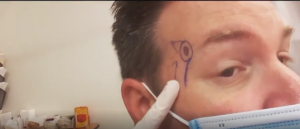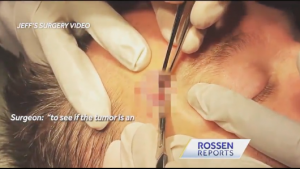Jeff Rossen Battles Melanoma Again
- Former NBC News correspondent Jeff Rossen, 44, shared details of his previously private battle with melanoma after being diagnosed with the deadly skin cancer for the second time. He previously beat the disease in 2013 after having a mole removed from his stomach.
- This time, Rossen explained that he would undergo the “groundbreaking” Mohs surgery, noting: “It’s increasing my chances of survival, and it could increase yours too, with early detection.” Two weeks after that aurgery he was declred cancer-free.
- Mohs surgery is quick, highly effective, and performed as an outpatient surgery. A surgeon will begin by slicing off the skin’s tissue layer by layer and giving them to a pathologist or personally examining them on a microscope. The doctor cuts until there is a transparent layer, which means the cancer cells are gone from that area.
“It’s skin cancer, melanoma. I actually had it before, this is my second time with melanoma, but this time, it’s bigger. And because of that, because it’s the second time, it’s scarier,” said Rossen in a video posted in his Instagram account.
Read More
“Early detection saved my life the first time. I’m sitting here today because early detection saved my life early ten years ago. And I’m hoping that early detection saves my life again, this time,” said Rossen.
His wife also deserves credit for that first diagnosis in 2013, having urged Rossen to see his dermatologist after she noticed a concerning mole on his stomach.
A surgeon removed that mole, and Rossen was declared cancer-free soon after that surgery.
This time, Rossen explained that he would undergo the “groundbreaking” Mohs surgery, noting: “It’s increasing my chances of survival, and it could increase yours too, with early detection.”
This time, the concerning mole was on Rossen’s forehead and visible to viewers of his segments, which he now does for Hearst TV.

His dermatologist had previously informed him the mole was not concerning, but that changed during his last visit when the mole’s color had become noticeably darker, according to his doctor.
“To get the cancer out of me, they’re performing a really cool surgery called Mohs surgery,” explained Rossen. “A skin cancer is a little like an iceberg, right? You can see the tip of it above the surface, but most of it exists beneath the surface that you just cannot see. Most surgery is the most effective way to get that tumor out and removes all traces of cancer cells.”
Rossen then took a camera crew inside as he had surgery, which ultimately left him with a quarter-sized hole in his face.
The doctor removed the tumor and scraped away some cells before examining the area under a microscope to ensure all cancerous cells are out. If they are not, the doctor will go back in and remove them in a second pass.
In Rossen’s case, the cut needed to be broader and deeper than anticipated, but it all paid off in the end.

Related: Signs of Skin Cancer Can Show Up On Your Nails, But Don't Jump to Conclusions Just Yet
“My surgery was a little less than two weeks ago, and as I sit here today, I am thrilled to tell you that I’m officially cancer-free,” announced Rosen.
“They got everything because of that Mohs surgery. They can tell me without a doubt that they searched everything around it in it. They went as deep as they had to and went as wide as possible to get all the cancer cells out. So I feel great about that.’
The only drawback is the large scar on his head and going public with a battle he hoped to keep private. But by sharing his story and encouraging others to get themselves screened, he is helping save lives.
What Is Mohs Surgery?
Dr. Frederick Mohs began to perform a procedure he referred to as chemosurgery in the 1930s that involved removing layers of tissue in surgical procedures and then examining them for signs of disease. His practices were later updated and slightly changed so that doctors could use his method to treat dermatological conditions, including skin cancers, thus giving the world Mohs surgery.
The procedure is quick, highly effective, and performed as an outpatient surgery.
A surgeon will begin by slicing off the skin’s tissue layer by layer and giving them to a pathologist or personally examining them with a microscope.
The doctor cuts the layers deeper and deeper until there is a transparent layer, which means the cancer cells are gone from that area.
That process all happens in real-time, giving patients peace of mind after they complete the surgery.
“So with most surgical procedures, you are taking a margin of healthy tissue, healthy skin around the tumor. And that margin is something that we come to as a standard of care based on lots of studies, literature, our experience. And so this is not necessarily an arbitrary margin, but a standard margin that we take around the cancer,” explained Dr. Sumaira Aasi, professor of dermatology and director of Mohs and Dermatologic Surgery at Stanford in a previous interview with SurvivorNet.
“And then that tumor is sent to a laboratory where it’s most often bread-loafed or sectioned. And the pathologist will look at various parts of this excised tumor and let the surgeon know whether they got it all out or not.”
That entire process is simplified and streamlined, however, for patients receiving Mohs surgery.
“With Mohs surgery, when we cut the tissue, we’re actually cutting it and looking at 100 percent of the margin. That really is what defines Mohs surgery from other excisional or tumor extirpation procedures,” said Dr. Asai.
Mohs Surgery Removes Skin Cancer With Smaller Incisions and More Certainty
Examining Your Skin for Melanoma: Remember ABCDE
Jeff Rossen has been doing regular self-checks on his skin for years.
It is essential for him as a skin cancer survivor and others because finding skin cancer early can save a person’s life.
Dr. Cecilia Larocca, a dermatologist at Dana-Farber Cancer Institute, recommends looking at your skin once a month for anything suspiciousand using the acronym ABCDE as a checklist:
Asymmetrical moles: if you drew a line straight down the center of the mole, would the sides match?
Borders: irregular, jagged, not smooth; can also stand for bleeding
Colors: multiple distinct colors in the mole
Diameter: larger than 6mm, about the size of a pencil head eraser
Evolution: This may be the most important thing that changes over time, such as gaining color, losing color, painful, itching, hurting, changing shape, etc.
Checking for Signs of Melanoma
Learn more about SurvivorNet's rigorous medical review process.


